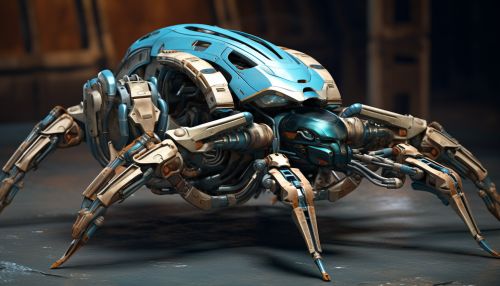Exoskeleton
Overview
An Exoskeleton is an external covering for the body in some animal species, particularly arthropods, providing both support and protection. Unlike the internal skeleton of humans and other vertebrates, exoskeletons are situated on the exterior of the organism, where they serve as a robust shield against damage from predators, the environment, and other external threats.
Biological Exoskeletons
Biological exoskeletons, also known as cuticles, are composed of a complex matrix of proteins and chitinous polysaccharides. These materials provide the exoskeleton with its characteristic rigidity and strength, while still allowing for flexibility and movement.
Arthropods
Arthropods are the most prominent group of animals that possess exoskeletons. This group includes insects, spiders, crustaceans, and other similar organisms. The exoskeletons of arthropods are segmented, allowing for a high degree of mobility while still providing an effective defense against predators.
Molting
One significant aspect of exoskeletons in arthropods is the process of molting, in which the animal periodically sheds its old exoskeleton and forms a new one. This process allows the organism to grow, as the rigid nature of the exoskeleton does not permit expansion.
Artificial Exoskeletons
In the realm of technology and engineering, the concept of the exoskeleton has been applied to the development of artificial exoskeletons or exosuits. These devices, which can be worn by humans, mimic the function of a biological exoskeleton by providing support, protection, and enhanced strength or endurance.
Medical Applications
Artificial exoskeletons have a wide range of applications in the medical field. They can be used to assist individuals with mobility impairments, allowing them to walk or move in ways that would otherwise be impossible. In addition, they can also be used in physical therapy and rehabilitation, helping patients recover from injuries or surgeries more effectively.
Industrial Applications
In the industrial sector, exoskeletons can be used to enhance the physical capabilities of workers, reducing the risk of injury and increasing productivity. These devices can provide additional strength or endurance, allowing workers to lift heavy objects or perform physically demanding tasks with less effort.
Future of Exoskeletons
The field of exoskeleton technology is rapidly advancing, with new developments and applications emerging regularly. As our understanding of both biological exoskeletons and the engineering principles behind them continues to grow, it is likely that we will see even more innovative and effective uses for these remarkable structures in the future.


